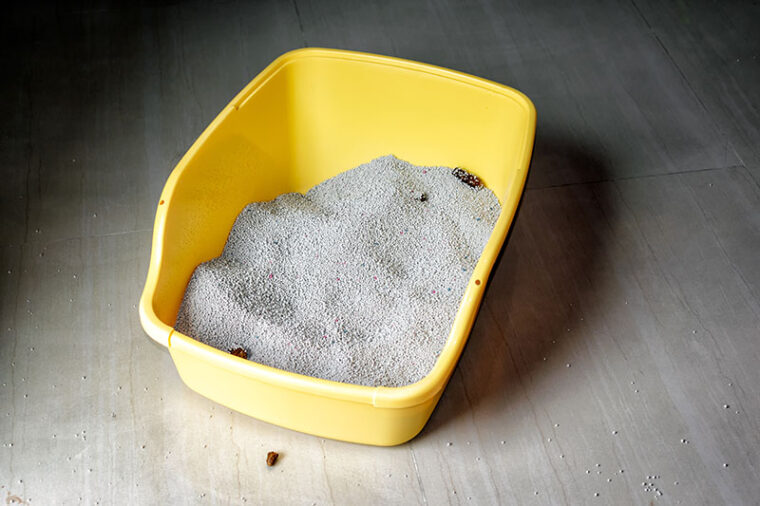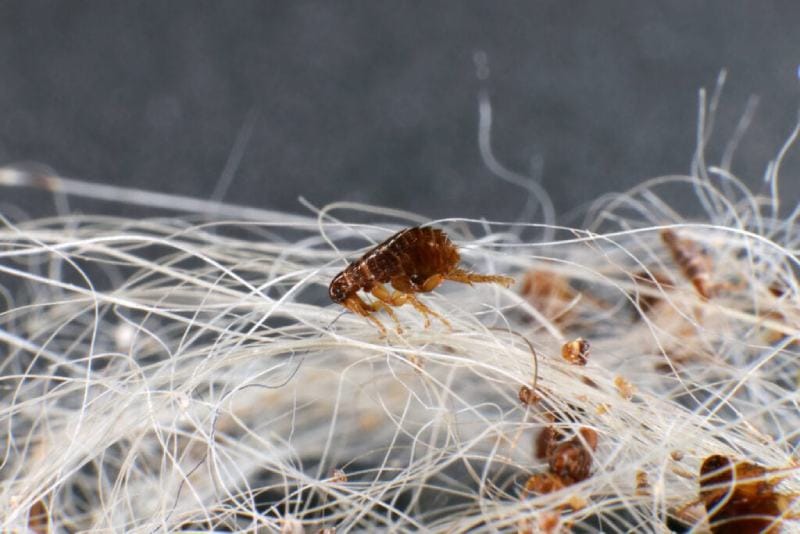
Click to Skip Ahead
It’s not the most pleasant job in the world, but keeping your cat’s litter box clean and pest-free is essential. Cleaning is imperative alone if just to control odors. It will also prevent other issues, such as the infestation of flies and other bugs, because a litter tray has many of the elements that makes it a breeding ground for pests. Insects, particularly flies, are carriers of many diseases which makes it a health issue for you and your pet if lots of flies are in and around the litter tray. Knowing what pests are in your home can help you eliminate them and avoid a re-infestation. We’ll discuss the ones you can see and the ones you can’t.
Pests You Might Find in a Litter Box
Fruit Flies
Fruit flies (Drosophila melanogaster) may be small, but they are incredibly annoying. You’ll most likely see them at the end of summer into the fall because they are attracted to ripe fruit and vegetables. They often hitchhike a passage into your house on fresh produce. Rinsing the food can help prevent a problem by removing fruit fly eggs from the surface. However, they can also fly into the house through windows and doors, attracted by the ripening food. All that is needed for fruit flies to breed is a moist layer of fermenting material, so they can multiply on a washing up sponge, a small amount of spilt fruit juice, or in the cat’s litter box!
An excellent way to eliminate fruit flies is to place a small dish of apple cider vinegar with a drop of dis soap where you’ve seen them. The liquid will entice them, while the soap, as a surfactant, will cause them to sink and drown. An alternative to the dish soap is a paper funnel through which the flies will go and then become trapped. They can then be released outside or disposed of.

House Flies
House flies (Musca domestica) are another scourge of pet owners. A dirty litter box is a magnet for these pests, and if your cat eliminates outside of the box, and it goes unnoticed, house flies will find it. Bacteria and mold that exist in huge numbers in dirty litter boxes are also a lure to the house fly. The chances are they’ll end up wherever the litter is if they’ve gotten into your home. They are especially insidious because of their role in the transmission of pathogens. The best way to control flies is to keep the box clean with daily scooping. You should also replace all the litter weekly, or more often than this if you have more than one cat. Don’t wait until your cat stops using it to do this simple task. Wash out the box with hot water and a mild detergent and let it dry before filling it again. Your cat’s naptime is a good time to do this.
Fleas
If your cat has fleas, they can be anywhere your pet goes in your home. These pests can transmit diseases and parasites to you and your family, making elimination imperative. Preventing fleas is much easier than getting rid of a problem. It involves cleaning places your kitty uses, such as their bedding, the carpets, and their litter box. Gladly it takes between 2 weeks to 2 months (depending on the temperature) for a flea egg to develop into an adult flea, so as long as you clean your litter box out weekly, the litter tray should not be a source of flea infestations. As well as treating the house with an effective insecticide, washing the bedding and hoovering the carpets, you must also treat all of your pets with an anti-parasitic medication at the same time. Several follow-up treatments are necessary afterward.

The “Invisible” Pests
Some bugs are especially aggravating because you can’t see them. You may see internal parasites, such as tapeworms (or segments of a tapeworm more commonly), hookworms, and roundworms when you clean the box. Tapeworm segments look like grains of rice whereas roundworms look like broken spaghetti. Intestinal parasites are more common in pets that go outdoors or catch prey.
If you see them in the litter box, your cat has been infected for a while. Deworming your pet is the best treatment. Consult your veterinarian for advice on which deworming product is best for the specific parasite of concern. Proper hygiene after cleaning the litter box will help to protect you against infection.
Diseases
Your pet’s feces can harbor other pathogens that can be really quite nasty. Cats can become infected by a parasite called Toxoplasma gondii from eating infected prey. Infected cats shed oocysts (the eggs of the parasite) in the feces about 3-10 days afterwards. These oocysts can infect humans through accidental ingestion. The concern is greatest with pregnant women and those with compromised immune systems. Daily cleaning can reduce your risk of getting this disease because oocysts need at least 24 hours to become infectious once they’ve been shed by the cat.
If your cat drinks water from puddles outside, that can increase their risk of getting giardiasis. This condition is caused by a tiny protozoan parasite that can live in contaminated water. An infected animal can pass cysts in their feces, putting pet owners at risk of an infection. Some cats are asymptomatic, whereas others may suffer from weight loss, acute, foul-smelling diarrhea and occasional vomiting. Humans can get it from their pets through environmental contamination.
Disinfecting the litter tray, litter scoop and the cat’s living and sleeping areas with a bleach solution, and then allowing it to dry for several days is the best way of eradicating the parasite.

Getting Rid of the Pests in the Litter Box
Proper sanitation can prevent most issues, as we’ve discussed. We recommend daily cleaning to remove waste. The longer it stays in the litter, the greater the chances of flies coming in, or accidental contact leading to health problems for you. Wet litter creates the perfect environment for bacterial and fungal development. We also suggest rinsing your scoop with a mild bleach solution.
You should take care of the area around the box and ensure you disinfect the poop scoop weekly too. If your litter tray is on a pad, wash it periodically. The same advice applies to any litter mats that aim to prevent tracking. Some pet owners find using liners makes cleaning easier, although some cats really don’t like them because they rustle.
We can’t overemphasize replacing all the litter weekly, following the manufacturer’s recommendations. It will cut down on odors and make a more pleasant environment for your cat. It can also reduce the risk of disease and parasites.
Our Favorite Products Incorporating Hepper's Advanced Bio-Enzyme Pet Stain & Odor Eliminator Spray and Litter Deodorizer fights even the toughest litter box smells. First, by keeping your litter box free of stuck-on messes each time you replace the litter, and second, by neutralizing odors upon contact.
Hepper Advanced Bio-Enzyme Pet Stain & Odor Eliminator Spray
Hepper Advanced Bio-enzyme Deodorizer & Litter Additive
Eliminates smells
Removes stains
Powdered/dry form
Liquid/wet form
Works on a variety of surfaces
Works inside your cat's litter
At Pet Keen, we've admired Hepper for many years, and decided to take a controlling ownership interest so that we could benefit from the outstanding designs of this cool company!
 Final Thoughts
Final Thoughts
Seeing bugs in your pet’s litter box is undoubtedly distressing. It’s a red flag that action is needed to ensure a healthy environment. These problems don’t go away on their own. Instead, they typically get worse. Understanding that risks exist even if you don’t see them is essential. It’s also a vital part of pet care. Fortunately, proper sanitation can prevent many issues before they become significant problems.
Featured Image Credit: Seika Chujo, Shutterstock








